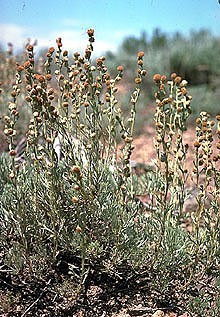Owyhee sage facts for kids
Quick facts for kids Owyhee sage |
|
|---|---|
 |
|
| Conservation status | |
| Scientific classification | |
| Genus: |
Artemisia
|
| Species: |
papposa
|
Artemisia papposa, also known as Owyhee sage, Owyhee sagebrush, or fuzzy sagebrush, is a special kind of flowering plant. It belongs to the aster family, which includes many plants like sunflowers and daisies. This plant is found in the northwestern United States, mainly in southern Idaho, eastern Oregon, and northern Nevada. It grows in an area called the Snake River Plain and nearby regions.
All About Owyhee Sagebrush
What Does It Look Like?
The Owyhee sagebrush is a small, fragrant shrub. It usually grows to be about 15 to 20 centimeters (6 to 8 inches) tall. It has several grayish stems that grow upwards. Its small leaves are gray-green and often have small lobes, meaning they are divided into rounded sections.
When the plant blooms, it produces groups of tiny flower heads. These flower heads contain yellow ray and disc florets, which are like tiny petals and centers of a daisy. After the flowers, the plant produces a fruit called an achene. An achene is a small, dry, one-seeded fruit. Unlike most other plants in the Artemisia group, the achenes of Owyhee sagebrush have soft, fuzzy hairs on top. These hairs are called pappi.
Where Does It Grow?
You can find Artemisia papposa in different types of habitats. It often grows in areas called sagebrush steppe, which are wide-open lands covered in sagebrush. It also likes meadows, which are grassy fields. Sometimes, it grows in alkali flats, which are dry lakebeds with salty soil. You might also see it where sagebrush and juniper trees grow together.
This plant shares its home with many other plants. Some of its neighbors include thymeleaf and mat buckwheats. You might also find it near lava aster, whip pussytoes, and onespike danthonia. Other plants that grow alongside it are western needlegrass, barestem biscuitroot, and Sandberg bluegrass.
Owyhee sagebrush prefers to grow in places that are not too high or too low in elevation. It often grows in shallow, rocky soils that do not drain water very well.
See also
 In Spanish: Artemisia papposa para niños
In Spanish: Artemisia papposa para niños


